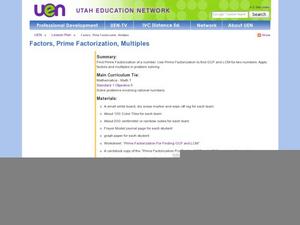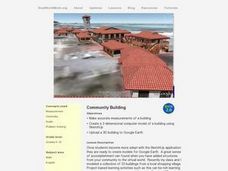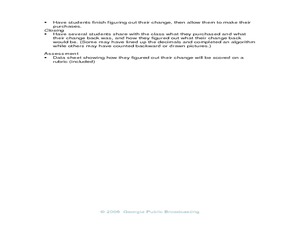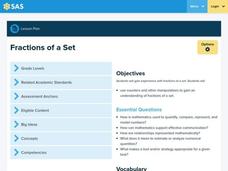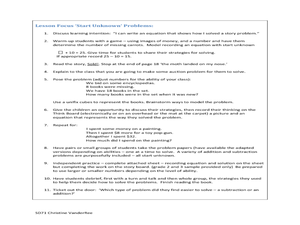Curated OER
Bar Charts and Pictographs: How can they help us?
First graders work with manipulatives to solve various math problems by using concrete objects to solve a list of problems . They create and evaluate bar graphs and write a statement about the information on their bar graph.
Curated OER
Primary Geometry
Students identity simple geometric shapes. In this early geometry lesson, the teacher introduces students to triangles, squares, and rectangles, then students identify and classify the shapes as they are found in the classroom. To...
Curated OER
Saving Makes Cents
Students identify ways families save money. In this financial instructional activity, students read the book A Chair for My Mother and discuss ways to save money. Students identify coin values and practice counting money.
Curated OER
Factors, Prime Factorization, Multiples
Seventh graders examine Prime Factorizations, Multiples, and Factors. In this prime number, factorization, and multiples lesson, 7th graders identify greatest common factors and least common multiples. Students use problem solving skills...
Curated OER
Triangle Attributes and Measures
Seventh graders explore the concept of triangles. In this triangles activity, 7th graders sort triangles according to various attributes such as acute, obtuse, isosceles, or equilateral. Students find the area and perimeter of triangles.
Curated OER
Box and Whisker Plots
Seventh graders explore the concept of box and whisker plots. In this box and whisker plots instructional activity, 7th graders plot data on a box and whisker plot. Students discuss the mean, median, and mode of the data. Students...
Curated OER
Linking Length, Perimeter, Area, and Volume
Students explore measurements of rectangles. In this measurement comparison lesson, students discover the length, width, perimeter, and area of two different rectangles. Students record their measurements on a chart to make comparisons.
Curated OER
Investing
Students collect data on investments and draw conclusions. In this algebra lesson, students analyze exponential graphs as they relate to money. They discuss the cause of an account balance being high or low.
Curated OER
Community Building
Students build different shapes using sketches. In this geometry lesson, students explore measurements and units as they build and create models of buildings. They use SketchUp to create and manipulate shapes.
Curated OER
Introduction to Fractions Using Cuisenaire Rods
Fifth graders use Cuisenaire rods in order to discover how to represent fractions with real objects. In this instructional activity on fractions, 5th graders first examine and learn the colors, lengths, and numerical values of each rod;...
Curated OER
Composite Functions
Young scholars create a poster to explain composite functions. In this composite function worksheet, students explore linear equations and functions. They complete a worksheet and use manipulatives to complete problems.
Curated OER
The Magic Pot
Students read the story The Magic Pot and complete language arts based activities based on the story. In this language arts lesson plan, students discuss, listen, observe, and complete language worksheets.
Curated OER
Grandfather Tang's Story
Students construct tangram patters. In this geometry lesson, students read the book Grandfather Tang's Story and visit various websites to practice covering figures with tangrams. Students attempt to construct animal shapes using puzzles.
Curated OER
Percents and Discounts
Students convert between decimals and percents. In this algebra lesson, students define percent as it relates to sales and tax. They calculate the percents of number using multiplication.
Curated OER
Investigation-Mathematical Reasoning: Tables and Chairs
Fourth graders design a table and chair arrangement. In this mathematical reasoning lesson, 4th graders place tables shaped like equilateral triangles so that they seat the appropriate number of guests.
Curated OER
Introduction To Functions
Students define a functions and solve problems using functions. In this algebra lesson, students differentiate functions from non-functions. They differentiate between polynomials of higher degrees.
Curated OER
SHHH It's a Secret
Pupils rewrite word problems using expressions and equations. In this algebra lesson, students use the correct variable to solve and write equations. They use the TI to graph their solution.
Curated OER
Unit 2 Sun & Stars
Students describe stellar objects using terms such as stars, planets, satellites, orbits and light. In this sun and stars unit, students research stellar objects through seven individual lessons discovering star characteristics, how...
Curated OER
Spending - Maintaining the skill of money
Third graders practice making change with money. For this subtraction lesson, 3rd graders watch a video about money. Students investigate what it means to earn money, spend it, and find their change.
Curated OER
Graph Creator
Students rewrite equations using algebraic symbols. In this algebra lesson, students graph linear equations using the slope and y intercept. They make predictions about their graphs and analyze the results.
Curated OER
Line, Ray, Segment
Students define vocabulary words. In this geometry instructional activity, students identify the graph as a line, ray or segments. They understand the properties of each and calculate the distance on a number line.
Pennsylvania Department of Education
Fractions of a Set
Students explore number sense by completing a number set worksheet. In this fractions lesson, students utilize pattern blocks as a visual reference to the fractions they practice identifying. Students read the book Clean-Sweep Campers...
Curated OER
Solve Story Problems: Sold! A Mathematics Adventure
Young mathematicians listen to the book Sold!: A Mathematics Adventure by Nathan Zimelman where they encounter ways to solve story problems. They then create and solve start unknown addition and subtraction equations. Resource builds in...
Curated OER
Grab a Handful and Count
Let's use Fruit Loops to teach counting skills! Students practice counting one-to-one correspondence using Fruit Loops with a partner and then compare them to see who has more or less.



